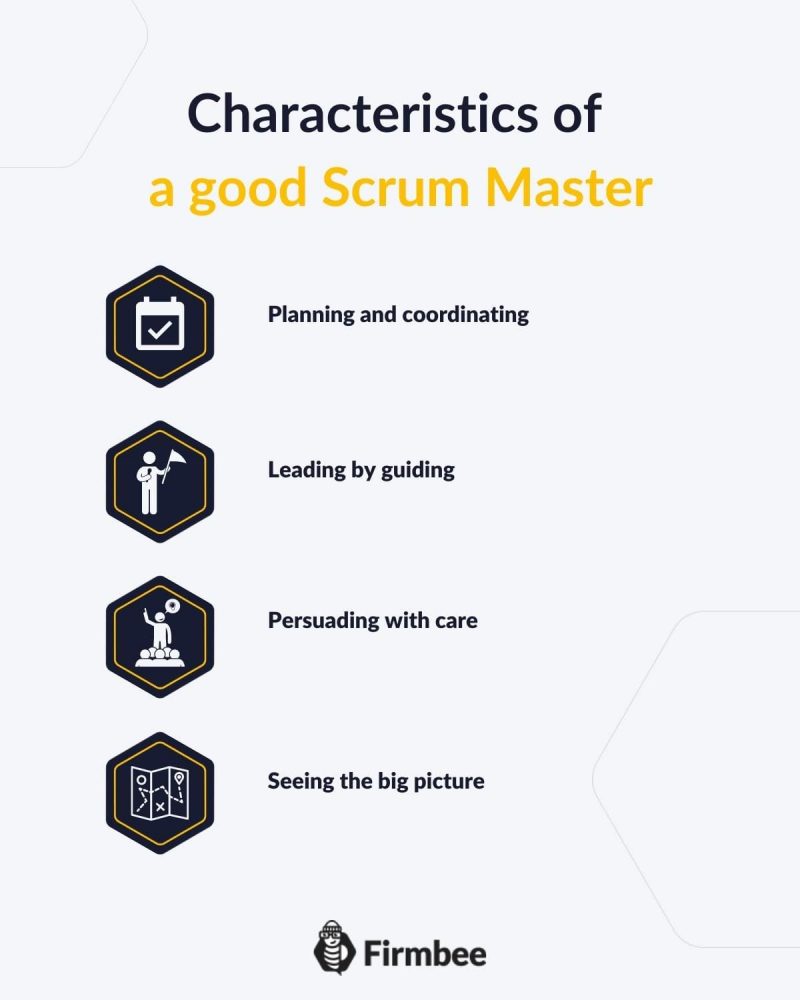What makes a good scrum master? To answer that question, we should first have a recap on who a scrum master is. It’s the position of team facilitator, a person navigating the team to reach its highest potential possible. Scrum master l of the team. And by removing obstacles that stand in the way of efficient increment execution. This requires the right outlook, approach to the problems encountered by the team and soft skills.
Characteristics of a good Scrum Master – Table of contents:

Planning and coordinating
The ideal Scrum Master is a person who could organize work brilliantly. This allows him to organize the Product Backlog efficiently and on an ongoing basis – one of the artifacts of Scrum that we will describe.
However, the Scrum Master’s organizational skills are primarily used to coordinate the work done by others. That’s why it’s good for him to be as efficient in organizing Scrum events, which we describe in detail in a separate article, as in moderating them. His tasks also include filling in missing information and answering developer questions. And facilitating access to training and tools for team members.
As we wrote in the previous article, Scrum Master is primarily concerned with working with people. By managing the team and ensuring smooth operation, each Scrum Team member knows their role scope of duties within the team. In other words, everyone knows what to do and why.
Leading by guiding
Scrum Master’s role has certain defined characteristics. Such as acting as a guide, a person leading the way to safety but restraining from imposing superiority. Like a facilitator, Scrum Master helps by pointing out ways to increase productivity and improve collaboration. In other words, a good Scrum Master doesn’t devote time to force decisions or solutions concerning the Product the team is creating. Instead, the main focus revolves around the team performance. By doing so, find effective solutions and suggests how to work together.
That is why it is so important for him to be able to ask questions. Questions that are not traditionally associated with the role of a manager. That is, instead of checking tasks and asking – were they done correctly and on time? And why not?
The good Scrum Master asks:
- How can I help you?
- What could help the team make progress on this project?
- Did we miss something?
- Have we covered all the issues?
- What else could go wrong?
- How much time is needed for this?
- Will we continue this approach in the next iteration?
Asking questions is not enough though. The key is the ability to listen and benefit from the knowledge, insights and assistance provided by the team.
Persuading with care
The basis of a Scrum Master’s strong position in a Scrum Team is to treat all team members equally. The key is to make sure that every member of the Development Team feels their contribution to the team is valued. The next step is to empower team members by supporting their professional and personal development. A Development Team composed of equal and confident individuals will strive to solve problems independently.
However, this means a much more difficult way of management than the traditional one. A Scrum Master should prefer dialogue and discussion over forcing, and guiding and asking questions over finding solutions for the Developers. This requires a lot of patience. But also decisiveness. After all, it’s not about leaving contentious issues unresolved.
That’s why Scrum Master has to master the skill of influencing the team. This requires high emotional intelligence. He usually doesn’t work in a position that would make him, in the traditional sense, the superior to the Development Team.

Seeing the big picture
The Scrum Master works inside the team, and does not look at the team’s work “from above”. However, this does not apply to all situations. By not being directly involved in the creation of the product, the Scrum Master can see patterns and dependencies that are invisible to the members of the Development Team.
This different perspective is also good for motivating others. It allows to set horizons for development and consistently supports the members of the Development Team in reaching them.
The ability to have a broader perspective of the team’s work will make it possible for a Scrum Master to suggest a systemic change in the approach, instead of helping the Developers to fix single, recurring mistakes. Energetic, another quality of a good Scrum Master, who can energize the team, also helps to support the new vision.
Good Scrum Master – summary
In today’s article we described the most important characteristics of a good Scrum Master:
- great organization work
- the ability to ask questions and use knowledge of others
- managing by the influence
- the ability to distance oneself
Obviously, the complete list of all Scrum master’s skills is vast. It’s safe to say though that it resembles the set of skills of a good project manager.
Conflict management, good persuasion, and teamwork skills are the foundations on which the detailed skills of a Scrum master arise.
If you like our content, join our busy bees community on Facebook, Twitter, LinkedIn, Instagram, YouTube.
Author: Caroline Becker
As a Project Manager, Caroline is an expert in finding new methods to design the best workflows and optimize processes. Her organizational skills and ability to work under time pressure make her the best person to turn complicated projects into reality.
Scrum Guide:
- Glossary of basic terms, roles and notions
- What is Scrum?
- Scrum values
- How to implement Scrum in your company?
- Scrum Team - what is it and how does it work?
- Who is a Product Owner?
- The most common mistakes of Product Owner
- Who is the Scrum Master?
- Characteristics of a good Scrum Master
- The most common mistakes of Scrum Master
- What statistics and metrics should the Scrum Master track?
- Cooperation between Product Owner and Scrum Master
- Development Team in Scrum
- The most common mistakes of Developers
- Scrum artifacts
- Scaling Scrum
- Sprint Backlog
- What is the Product Backlog?
- What are User Stories?
- Creating the best User Story with INVEST
- The most common User Story mistakes
- User Story Acceptance Criteria
- Estimation and Story Points in Scrum
- Planning Poker
- Team Estimation Game
- Defining Increment
- Scrum events
- What is Sprint in Scrum?
- Scrum Team Commitments - Product Goal, Sprint Goal and Definition of Completion
- What is a Burndown Chart?
- How to create and interpret a burndown chart?
- Advantages and disadvantages of the burndown chart
- Kanban boards in Scrum and Scrumban
- Velocity in Scrum - Speed of the Development Team
- Daily Scrum
- Sprint Planning
- Sprint Review
- What is a Sprint Retrospective?
- Common mistakes during a Sprint Retrospective
- Product Backlog nurturing


















